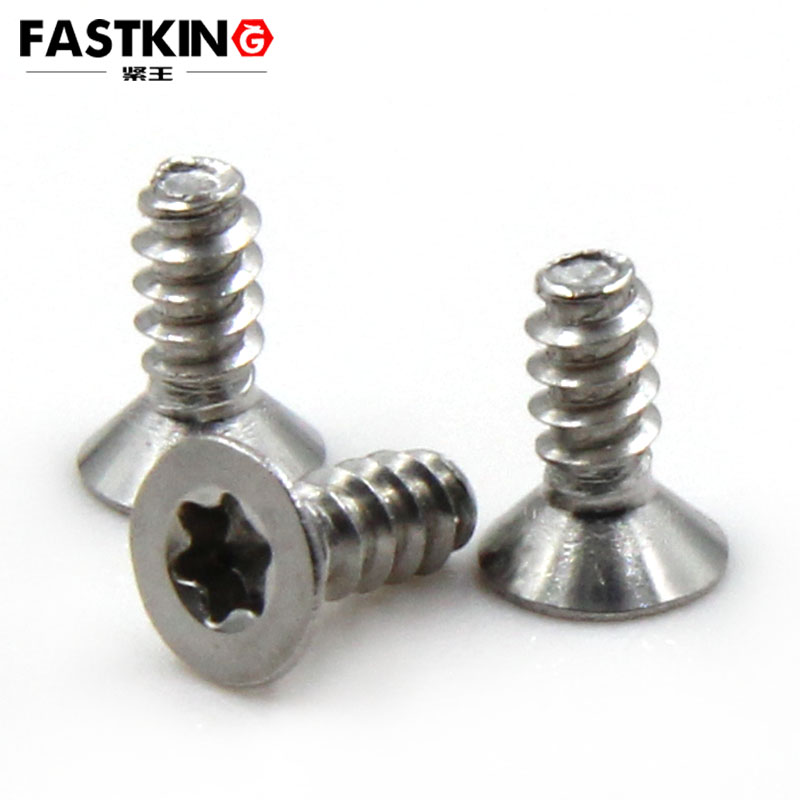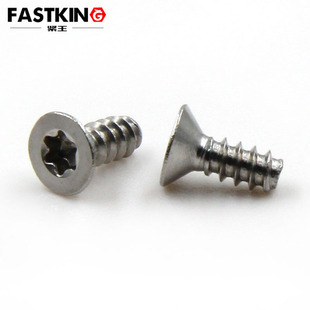- Torx screw,torx machine screw,torx self tapping screw
- sales@jlfastener.com
Countersunk head inner plum flat tail self tapping screws
Torx tapping screw
Countersunk head inner plum flat tail self tapping screws
- Description: self tapping screws
The "internal hexagon socket" structure endows the screw with enhanced operational reliability and safety. Compared with traditional slotted (flat-head with single slot) and Phillips-head designs, the internal hexagon socket forms a tight engagement with a dedicated tool via its hexagonal curved notch, achieving a torque transmission efficiency of over 95%. It can withstand greater fastening force and effectively prevent damage to the screw head caused by "slippage" (tool slipping out of the slot). Meanwhile, the internal hexagon socket requires a dedicated wrench for operation, which can prevent unauthorized disassembly by non-professionals. In scenarios such as security equipment (e.g., smart door locks) and precision instruments (e.g., blood glucose meters), it safeguards the internal structure from arbitrary modifications, enhancing the safety of equipment use.
The "flat tip" design is what distinguishes this screw from pointed self-tapping screws. When traditional pointed self-tapping screws are driven into soft materials (e.g., plastic, wood), the sharp tip tends to penetrate the component or cause material cracking—especially in thin plastic parts (e.g., home appliance panels), leading to a high rejection rate. The flat tip design, however, uses its smooth end surface to evenly compress the material and form threads during insertion, avoiding puncture damage to the material by the sharp tip and reducing component deformation caused by over-insertion of the screw. Data shows that when connecting ABS plastic parts with a thickness of less than 3mm, the material cracking rate of flat-tip self-tapping screws is reduced by more than 60% compared to pointed self-tapping screws, significantly improving product yield.
The "self-tapping thread" feature is the core that enables countersunk-head internal hexagon flat-tip self-tapping screws to boost assembly efficiency. Traditional screws require pre-tapping with a tap before installation, which not only increases process time but also may lead to thread mismatch due to insufficient tapping precision. Self-tapping threads, through their special thread profile design, can automatically cut the material to form matching threads during insertion, eliminating the need for an additional tapping process and shortening assembly time by approximately 30%. For example, in the assembly of smart speaker casings, workers do not need to tap the plastic casing first; they can directly drive the screw in with an electric tool to complete the fixation. This not only simplifies the process but also avoids assembly failures caused by tapping errors.

In terms of performance, the "adaptability" and "durability" of countersunk-head internal hexagon flat-tip self-tapping screws are particularly prominent. In terms of materials, mainstream products are mostly made of 1022 low-carbon steel (after carburizing) and 304 stainless steel. Among them, 1022 steel can reach a surface hardness of HV550-650 after heat treatment, which not only ensures cutting capability during self-tapping but also provides a certain degree of impact resistance; 304 stainless steel is suitable for humid environments, such as bathroom appliances and kitchen cabinets, and can be used for a long time without rusting. Taking the casing of an indoor air conditioner as an example, countersunk-head internal hexagon flat-tip self-tapping screws made of 304 stainless steel show no rust even after 5 years of use in indoor humid environments, and the flat tip design prevents damage to the plastic casing, ensuring the stable structure of the air conditioner body.
From the perspective of application scenarios, this screw has a wide adaptation range covering multiple core industries. In the electronics industry, it is used for fixing the casings and motherboards of routers and set-top boxes—the countersunk head design ensures a flat equipment surface, and the self-tapping feature simplifies production line processes; in the furniture industry, it is used for fixing laminates and connectors of panel furniture—the flat tip design prevents wood cracking, and the internal hexagon socket avoids panel damage caused by "slippage" during installation; in the home appliance industry, it is used for fixing washing machine control panels and refrigerator drawer slides—the self-tapping threads can adapt to plastic parts of different thicknesses, eliminating the need to customize taps of multiple specifications and reducing the procurement costs of enterprises.
However, to give full play to its performance, attention must be paid to details during selection and installation. During selection, the appropriate specification should be chosen based on the material thickness: for connecting thin plastic parts of 1-2mm, the M2.5×6 specification is recommended to prevent the screw from being too long and penetrating the component; for connecting wood or thick plastic parts, the M4×10 specification can be used to ensure full thread engagement. During installation, the torque must be controlled—for example, the recommended torque for M3 specification screws is 1.2-1.5N·m. Excessive torque may cause the countersunk head to break, while insufficient torque may lead to loose connections; at the same time, it is necessary to ensure that the counterbore depth matches the screw head height—usually, the counterbore depth should be 0.3-0.5mm greater than the head height to prevent the head from being exposed.

The emergence of countersunk-head internal hexagon flat-tip self-tapping screws is a typical innovation in fasteners, evolving from "single-function" to "multi-function integration". It not only meets the requirements of modern industry for assembly efficiency but also takes into account the delicacy of product appearance and reduces the risk of material loss. As industrial manufacturing upgrades towards "lightweight" and "refinement", the application scenarios of this type of screw will be further expanded. For example, in the connection of new energy vehicle interior parts (e.g., central control panels), it can adapt to thin plastic parts while meeting the requirements of flat surface and rapid assembly. In the future, with the upgrading of surface treatment technologies (e.g., environmentally friendly galvanizing, chromium-free passivation), its corrosion resistance and environmental performance will be further improved, providing a higher-quality fastening solution for high-end manufacturing.


